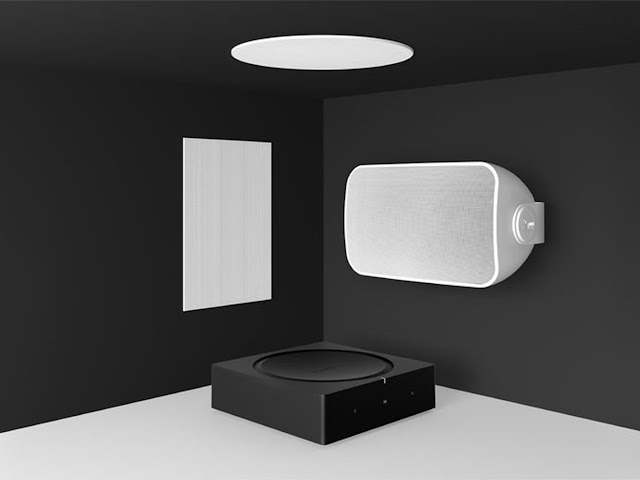 |
| image credit: SONOS |
Sonos Architectural
STEREO FOR ANY WEATHER
When it gets too hot, we leave the stuffy rooms for some fresh air. But this does not mean that the musical experience should be left at home. You need to take your music with you. But how can you do this without sacrificing sound? A simple portable Bluetooth speaker is sometimes not an option. There is a better solution. Much better solution. Namely, outdoor speakers for wall mounting.
STEREO
First of all, it is important that the sound is stereo, that is, with two speakers and with a large enough distance between them to provide a large soundstage. This is where all compact portable speakers play out. Well, except for those that can be paired.
Weatherproof acoustics are generally a permanent solution in the outdoors. It's not very practical to lug the two speakers back and forth, store them in the garage when not in use, and look for them again the next time you need them. One of the reasons we decided to do this test.
STREET SPEAKERS FOR WALL MOUNTING
These are outdoor speakers that are mounted on a wall or ceiling. These are ordinary passive speakers that are connected to the amplifier using speaker cables . The usual, old-fashioned way. It is very similar to home bookshelf speakers with one important difference: they are weather-resistant and can withstand both wind and rain. But not frost and ice, so do not use street speakers when winter comes. Almost all outdoor speakers are very easy to install and can be easily detached from the wall bracket if you wish to remove them during the winter season. The bracket with cables is usually left outdoors all year round.
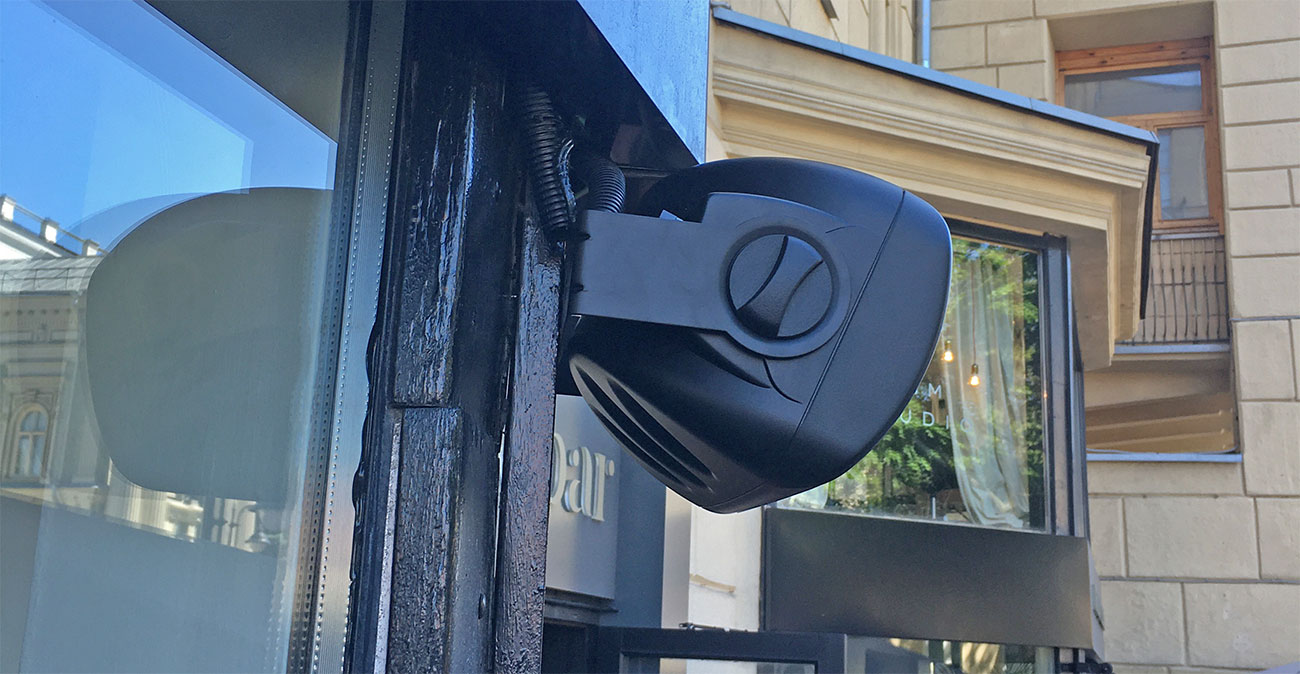 |
| IMAGE CREDIT: SONOS |
All outdoor speakers in this test came with the included wall mount. In the photo all-weather acoustics Jamo I / O 4 (White)
ACCOMMODATION
Don't underestimate speaker placement. Think before you mount them. If you want the sound to cover a large area, such as a large terrace or garden, the speakers can be conveniently mounted on a wall at a height of more than two meters. Preferably under the eaves or under the ceiling if you have speakers on your terrace. Then you can easily extend the season with the heater when the time is right!
If, on the other hand, you want sound for a small group of seated people and perhaps the most accurate perspective when sitting alone, then the speakers can be attached in a lower position, perhaps even at ear level when you are seated. Just like inside. Then you get a more focused stereo image.
All speakers in this test are adjusted at the same angle along their axis. Whether the speakers will be wall-mounted vertically or horizontally depends on how you want to adjust the angle. A rule of thumb is horizontal installation when placed at high level and vertical when placed at ear level.
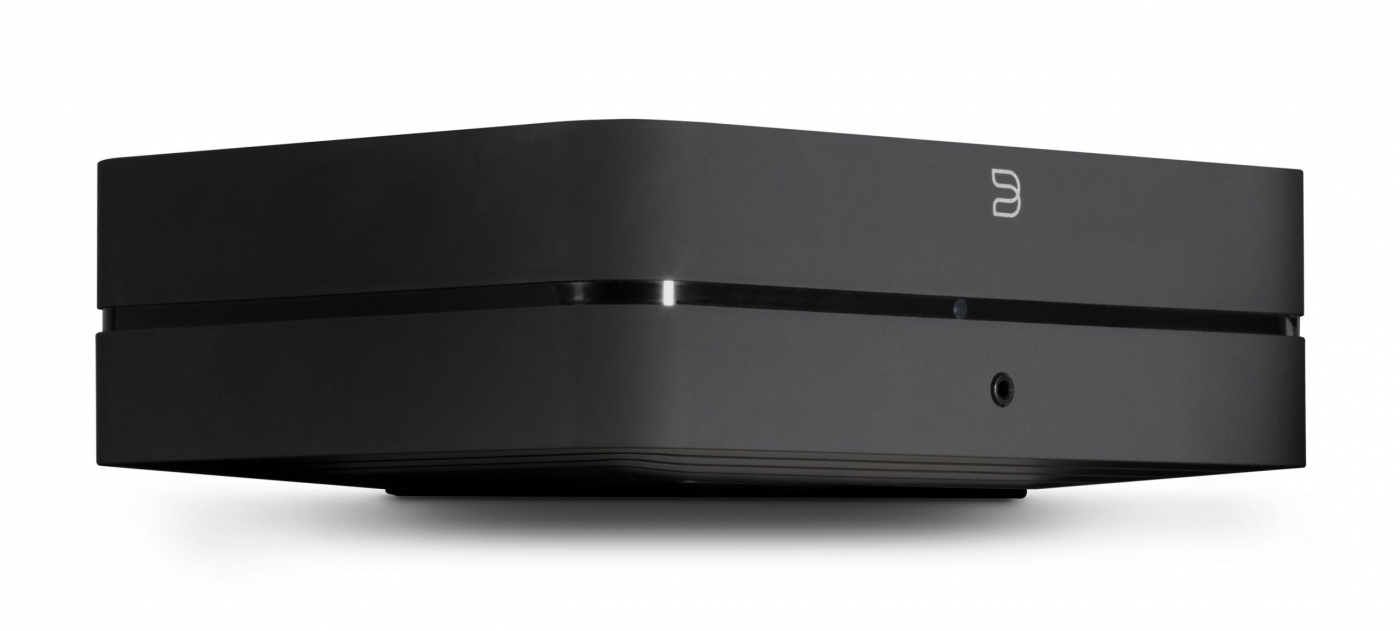
The Bluesound Powernode 2i is an example of a really good small amplifier that I recommend for outdoor speakers. But the amplifier itself must be indoors!
DON'T FORGET ABOUT THE AMPLIFIER!
Since these are passive speakers, you will also need an amplifier. We recommend an amplifier with built-in Wi-Fi or Bluetooth streaming for easy playback. It needs to be compact but still have enough power to be fun! We can recommend the Yamaha WXA-50 , or if you need the extra power and the ability to play music in higher resolution (although that's not really a top priority here), the Bluesound Powernode 2i is even better.
Please note that the amplifier must not be left outside. It must be located indoors and have Internet access so that it can stream music seamlessly. Speaker cables should be designed for indoor and outdoor installation and at least have an external insulator resistant to temperature extremes of UV radiation and preferably halogen-free. These cables are commonly referred to as installation speaker cables .
SIX DIFFERENT OUTDOOR SPEAKERS
We tested one pair of speakers from each of six different manufacturers, with an average price of around RUB 40,000. Keep in mind that you pay a little more for weather resistance, as reliability takes precedence over the ability to reproduce the finest details of a musical composition. As practice shows, a pair of regular bookshelf speakers for indoor use will cost about half the price for the same quality compared to dedicated outdoor speakers.
HOW WE TESTED
Sonos Architectural speakers are tested both outdoors and indoors. When doing group testing of many products, it is important that you can switch between them rather quickly, so instead of mounting all pairs on the wall one by one, we placed them on racks, right up against the outer wall. Thus, we were able to quickly switch back to a previously tested pair, if there was a nuance in which we are not sure.
We used the same racks in our test room, also mounted against the wall to best simulate wall mounting. It should be emphasized that the differences we heard between the speakers outdoors were repeated indoors as well.
Sonos Architectural
Sonos has entered unfamiliar territory for the first time in the art of passive speaker design. What they do best is active wireless multi-room speakers. And for customers looking to keep their existing stereo speakers in the living room, Sonos has always offered an amplifier with built-in streaming. And for the sake of simplicity, it's simply called Amp.
But apparently someone thought: "Why not become a one-stop supplier?" There are no passive speakers in the Sonos product listing that can be controlled with an amplifier. Then the choice fell on the speakers for wall and ceiling mounting, as customers using multiroom systems love hidden installation.
And then Sonos did something smart. Instead of trying to make their own speakers, they chose a third-party manufacturer for the job. In particular, Sonance, which is widely known for its high quality built-in and outdoor speakers.
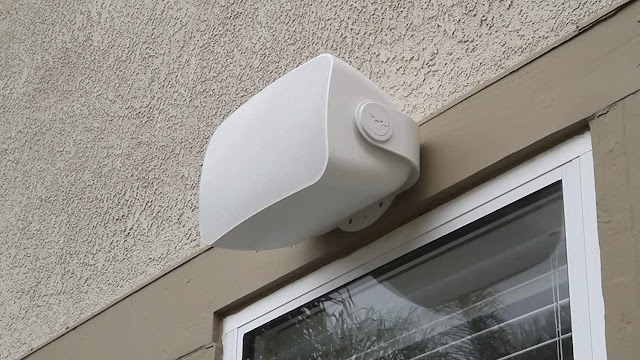 |
| IMAGE CREDIT: SONOS |
Powered by Sonance's Mariner
Sonos Outdoor is based on Sonance's Mariner series. Their size sits between the two largest models, the Sonance Mariner 66 and the Mariner 86 . In terms of appearance, they are almost identical, with the same type of pivot stand solution and speaker terminals on the front, hidden behind a cover.
But where Sonance uses Kevlar / Nomex lined woofers to reduce distortion, Sonos speakers don't. A cheap polypropylene cone is used here.
The speakers are waterproof but do not have official IP certification. Looking at Sonance's all-weather acoustics , we can see that the Sonance Mariner series are IP66 rated, which means they are completely dustproof and can also withstand strong water ingress from all directions.
It should also be noted that while Sonance offers its speakers in black or white, Sonos has only opted for white. Which is likely to throw off some potential customers.
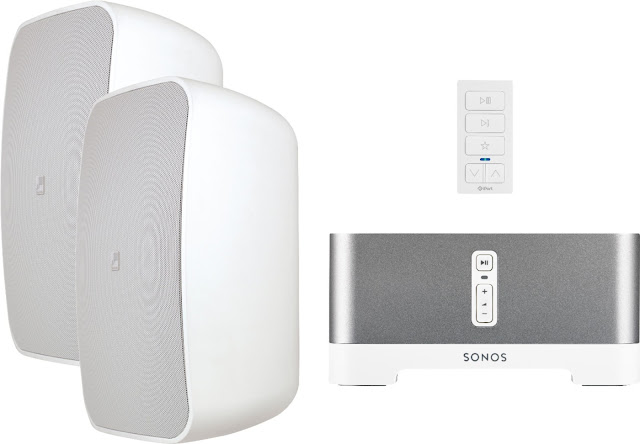 |
| IMAGE CREDIT: SONOS |
No obvious benefits with Sonos Amp
While Sonos wall and ceiling recessed wall and ceiling recessed speakers provide automatic room correction (TruePlay) in the Amp, you don't get those benefits with Outdoor. The only thing that happens when the amplifier detects that it is connected to it is that you are told that a Sonos Architectural speaker is connected, but no additional custom functionality appears in the app. But there is impedance detection in there, which connects the overvoltage protection and also allows the amplifier to drive three pairs of speakers instead of the two as provided. But from an acoustical point of view, connecting an Outdoor to an amplifier does not offer any advantages.
Sonos Outdoor Sound
That Sonos speakers are more expensive than comparable Sonance speakers is not easy to understand when you see that cheaper woofers are used here. And it's even harder to understand when you listen to them!
It's not that the speakers are doing something particularly wrong. The music sounds clear enough, the singing voices sound about as expected, and this is not the case with bass rumbling, drowning out the mids and adding discoloration to the music.
The problem with Sonos is that they are so anonymous. Mac Miller's voice is clear, but lacks power and physique. It doesn't have the same touch and drive in the midrange as the Monitor Audio Climate 60 , and Sonos doesn't have as much spread and gigantic sound image as the Focal 100 OD8 . Violins never bite properly, there is nothing to attract.
The bass is still quite full and well balanced. But where is the control? Ariana Grande's bass rhythms smooth out the dynamics if the volume is turned up a bit, and the chamber orchestra lacks dynamics to turn on. Sonos is beaten by Focal and crushed by Bowers & Wilkins .
 |
| IMAGE CREDIT: SONOS |
Conclusion
Sonos Outdoor is a tough nut to crack. On the one hand, the speakers play well. But what about the dynamics? She simply does not exist, to these speakers, we do not want to dance. The bass is weak, the mids are too, and, frankly, there is a lack of high-end resolution.
Everything could be forgiven, and we would probably give the Sonos Outdoor four stars if they cost about the same as the rest of our test speakers. But for this money they have to play better. Therefore, only three stars. Alas and ah.
Sonos Outdoor Features
- Type: two-lane, closed box
- Recommended amplifier power: 5-100W
- Sensitivity / Resistance: Approx. 90 dB / 6-8 ohms
- Dimensions: 19.1 x 32.9 x 19.9 cm (W x H x D)
- Weight: 4 kg.
- Colors: white
- Water resistance: not specified
- Other: swivel wall bracket
- Price: 69,990 r. thing.
- Web: sonos.com











.jpg)


.jpg)



0 Comments